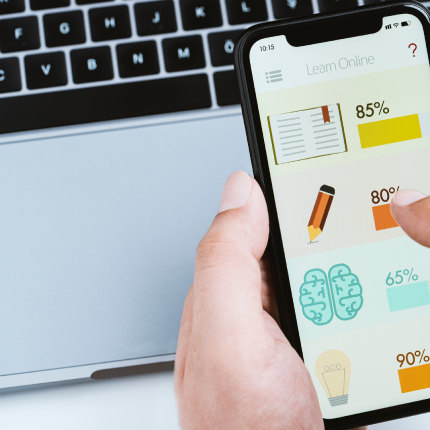Have you ever been in a situation where there are so many conversations going on and you want to focus on one but worry you might miss out on another?
FOMO!
The truth is, we're all in this situation right now.
We are talking about the content-rich world - the “Internet”.
And, it is not just audio conversations, but also visuals - videos,infographics, interesting articles, and social media posts.

We live in a sea of content, so to get people's attention we need to hit their subconscious, and that's where content distribution comes into play.
As we preach "content is king" and to produce consistently, we have been telling you to create more.
Well, the world has listened.
With generative AI, content is a commodity and creating it has never been easier.
We have reached a saturation point, where good content is sinking like a stone in the Internet ocean. Quality content is simply another facet of it.
So, If Content is King, Distribution is Queen and makes it survive.
We'll talk about how to distribute your content more effectively across different channels, discover new strategies, and transform your content into something more.
Before we move forward, let's understand;
What is Content Distribution?
Content distribution refers to anything brands do to ensure that their content reaches their target audience.
Among the many content distribution platforms, there are three main categories - Paid media, Owned media, and Earned media. (We will get into them later in this post).
It is not enough to simply publish content; you have to distribute it to make sure people see it.
For your content to stand out from the noise, you must not only produce high-quality content consistently but also distribute it strategically.
3 Components of Content Distribution Strategies:
- High-Quality Content - Good & effective content is essential for success
Quality content is a must - that's something no one will argue about.
Although some content creators are still convinced that quality content is all we need. But, that’s not true.
Here’s the proof.

- Target Audience - Know who you're Writing for.
Knowing where your readers look for new content and where they hunt for it will help you identify your content distribution channels.
Analyze your Google Analytics traffic sources and see how readers are finding your content.

Another way to figure out what content distribution channels are right is to simply ask.
Using a tool like Hotjar, you can create a pop-up survey from your site or send out an e-mail reader survey to your subscribers.
- Consistency - Long-term commitment to content consistency
There is never an end to content distribution. It needs to be done consistently.
Distribution channels evolve along with your audience.
Why Content Distribution is more important now than it has ever been?
Long gone are the days when you wrote content, pressed publish, ranked in the SERP, and were certain that high-quality traffic would flow into your landing page.
In the era of Generative AI, content is more plentiful than ever.
According to Hubspot’s Marketing Statistics report, 82% of marketers are actively using content marketing, which states that you have more competitors now than before.
Additionally, there are more channels for distributing content nowadays.
Let’s check out the four main reasons to take content distribution seriously:
1. There's a ton of good content out there
Several brands have built impressive content development processes, so we continue to see great content from them.
It usually contains original content, thought leadership posts, and much more.
Take Groww for instance. They have lots of helpful resources for selecting investing and finance options.
They are using their Instagram accounts and blog to create and distribute content.


It is good to have great content, but it is even more important to have great content from competitors so as to compete for the attention of a customer.
Check out Zerodha
They are using the Social Media platform - Instagram to communicate with aspiring traders and encourage them to utilize their platform.

Furthermore, they are distributing their content as sponsored content in various publications.

Moreover, it shows why relying exclusively on SEO, or even worse, a spray-and-pray content distribution strategy is dangerous to content ROI.
2. Competition has Never been Greater
49% of the marketing teams are allocating 30% to 50% of their budget to content.
That’s huge!
This growth in budget, and therefore competition, shows no sign of hitting the brakes.
Content Marketing Budgets

Planning in 2024: The State of Media & Content
Moreover, as more and more companies enter the market, there will be greater competition, search engines will be overloaded, and less unique content may be found in SERPs.
Even if your content is top-notch, it might end up buried on search engine results page 2 and beyond where you will barely get any clicks.

Therefore, you need to make use of your content distribution channels to the fullest extent.
That's the only way to avoid creating content that's never been read, viewed, or heard.
3. It's harder than ever to find good content
One reason for today's mediocre content is the increased number of competitors.
Brands often choose low-quality content when their marketing budget isn't as generous as the top guns within their field.
A second challenge is to hire and manage quality content creators.
It is important to look beyond human-generated content when you think of mediocre content. Take AI-generated content into consideration because it can be equally as bad.
When people distribute such content, they will overload the audience with useless content.
That's not what you want.
To ensure your audience can access excellent content and get a great sense of your brand and industry, you need to be on top of your content distribution game.
4. Various content distribution channels are available now
As early as 2000, there were only a few popular social media platforms and forums such as Reddit, Facebook, Twitter, Instagram, and LinkedIn.
In recent years, technological advancements have resulted in products such as Slack, Discord, and many more.
All of these platforms have gained an audience that spends time on them.
Content Distribution Channels
As we look at these channels, we’ll see how they can help you reach your Ideal Customer Persona (ICP) and engage them in the content you deliver, which in turn drives your revenue.
You can think of blogging, ebooks, infographics, YouTube videos, etc., and distributing them across the web is known as content distribution.
If done right, it allows you to be sure that every piece of content you create reaches the right audience.
While marketing teams spend hours creating content, they don't see any results from those hours.
It's because so many fail to distribute content in a way that results in traffic and leads. Moreover, many ignore the content distribution altogether.
As we’ve said before, Content is no longer king—Distribution is.
Your job is not over, just because you hit Publish. If no one sees your content, they cannot know whether it is well crafted and executed.
Content assets such as videos, blog posts, webinars, podcasts, and dozens of others have their own unique qualities, and distribution channels are no different.
Further, the audience of any content distribution channel, along with your level of resources, plays a vital role in determining its effectiveness.
What Are The Different Methods Of Distributing Content?
How and where you distribute content online can be broken down into three categories:
Earned Channels:
Earned distribution channels are used to promote your content by you and third parties.
Earned channels bring you more views, shares, links, and mentions since your quality content assets will naturally attract more engagement.
You can use earned distribution channels such as:
Guest Posts & Mentions
Community Distribution Channels
Slack Groups
Quora
Reddit
Paid Channels:
You have to pay for access to paid distribution channels.
Your content will reach a wider audience if you have more money.
When you combine owned and paid channels, your content will reach more people, increase audience share, and make your brand more visible.
You may want to consider using the following paid distribution channels.
Quora Ads
LinkedIn Ads
Facebook Ads
Pinterest Ads
Owned Channels:
These are the companies' own channels for distributing content, such as LinkedIn, Facebook, Instagram, Twitter, and other social media or similar platforms.
You are in charge of determining when and how often your content will go out on these channels.
We have compiled some owned distribution channels you should use, along with some best practices you should consider.
LinkedIn
Twitter
Facebook
Instagram
TikTok (if available at your location)
Medium
LinkedIn Newsletter
Email
Podcast
Pinterest
Youtube
This has been beautifully explained by Column Five Media through an infographic.

Each content distribution channel, as well as each online community, isn't right for your brand.
You have to remain adaptable and experiment with your approach, even if a channel works now, it won’t be the same tomorrow.
How to Identify Profit-making Content Distribution Channels?
1. Find out where your audience is hanging out online
While your ideal audience might be spread across multiple distribution channels, it is possible to find these channels by looking at how your competitors use them.
Check out where and what content your competitors are distributing.
Among the top channels to consider are Social Media - Facebook, LinkedIn, Twitter, Instagram, and YouTube.
For instance, B2B SaaS companies would immediately recognize LinkedIn as a possible distribution channel as brands such as Freshworks target LinkedIn as a channel to attract ICPs.
2. Analyze the distribution channel engagement
There is a possibility that your audience is present on one of your distribution channels, but does not engage with your content.
This can happen for several reasons.
B2B decision-makers spend most of their time on LinkedIn.
According to LinkedIn themselves, elevated shares expand reach 10x, earn 53% more engagement with sponsored content which is 2x higher CTR on employee shared content and deepen relationships by 30%.

Thus, you can expect a high level of engagement from your LinkedIn content.
Certainly, you can find data insights into how other channels are performing.
3. Find out how competitive the distribution channel is.
A distribution channel's level of competition depends on a wide range of factors.
When did you begin using the distribution channel?
Do your competitors regularly post content to the distribution channel?
What strategies do competitors use to engage with the channel?
Do you have any insight into what works and doesn't work for them?
Understanding how you are doing and where you want to be in terms of content distribution allows you to make better decisions.
4. Find out how many people the distribution channel reaches
Most distribution channels limit the reach of their content. Take social media platforms, for instance.
You can determine how quickly your content will gain traction in the feed by considering the following factors:
Who posted it
Type of content
Post interactions

By tracking your audience reach, you can tailor your content for every distribution channel you use.
5. Identify challenges to using distribution channels
It is important to set aside a budget for a distribution channel.
As a founder or a marketer, you will no doubt have a lot to do.
Consequently, you might not have as much time as you'd like to prepare and publish your distribution content.
So, you might need to hire dedicated content distribution specialists or agencies who understand your industry and have the necessary skills.
6. Test your content idea before creating it
Test your content on different distribution channels to determine if it will succeed on that channel.
Take a look at the quality of engagement.
Getting tons of likes and comments isn't very valuable if the people who like and comment aren't your ideal customers.
Even if someone shares your content or engages with it, figure out why they are doing so.
What do they think of the content?
Why are they resharing and what do they say while doing so?
When you know all of these things, you'll be able to decide when it's best to continue developing the content idea.
Content Distribution Strategy
Until now, we have understood that without content distribution, most of your content would never reach your audience.
Unless they know what your product is and how it can help them reach their goals, they won't know what it does and how it can benefit them.
If you do not have enough leads, you can't sell your product.
As we are now smart enough to realize that content distribution does not mean spamming forums, posting links on social media, or attempting to generate leads with poorly thought out ads.
We understand that not every channel will work, and even if a channel works, the results won't be the same every time.
Blogs, ebooks, email newsletters, podcasts, webinars, and other content assets turn into consistent sales leads when you combine exceptional content with a solid content distribution strategy.
Basically, we're talking content that builds brand awareness, generates leads, and opens the door for potential customers to get in touch with you.
We’re going to discuss everything you need to know about developing a rock-solid content distribution strategy.
Before we go any further in the process, we should first understand what Content Distribution Strategy is.
A content distribution strategy is a detailed plan that a company uses to guide and promote content assets such as articles, ebooks, and resources.
Developing a content distribution strategy has a number of benefits.
Using a document like this makes the promotion and distribution process more structured and eliminates chaos.
With the right content distribution strategy, you reach the right audience at the right time and encourage them to take action with your content, whether you want them to download an ebook, register for your newsletter, or schedule a call with you.
As we now understand what a content distribution strategy is and why it is important, let's walk you through the steps.
Step-by-step process of creating a content distribution strategy
Step 1: Know who you're targeting
We’re sure you’ve heard of user personas and understand how important they are to your content marketing strategy.
As per Ardath Albee, B2B Marketing Strategist & CEO of Marketing Interactions, Inc.
“A buyer persona is a composite sketch of a key segment of your audience. For content marketing purposes, you need personas to help you deliver content that will be most relevant and useful to your audience.”
Creating buyer personas may not be something every business takes the time to do, but by creating them, you can be sure you're delivering relevant content at the right time.
MailChimp excels at creating personas, a fact that can be seen both in their content creation and distribution.

Perhaps you would like to know how persona development relates to content distribution?
Using personas will help you imagine what your customers need and want and what kind of content they would find valuable.
You will get really good at content distribution when you know those things, not just because you create content that's aligned to what your audience wants, but because you distribute it in ways that meet the demands and preferences of that audience.
Don't worry if you don't have a clearly defined persona - just think about it a bit and answer these questions:
- Where can we find them?
- Who will be most benefited from the content you create?
- Do they have the power to make decisions?
- How are they connecting with your brand through your content?
Step 2: Find out the platforms where your audience hangs out
Find out where your ideal target audience hangs out and make sure that your content reaches them there.
Depending on what you analyze, you might post on LinkedIn, Twitter, Reddit, or Quora, or you might even pay for promotions on those sites.
Whichever distribution channel you choose, make sure it aligns with what you want your target audience to do.
As well, take full advantage of your own distribution channels, including your blog, email newsletter, and social media accounts, since they tend to cost less and can be managed by you.
Step 3: Go over your content
It's likely that you've already published some content, including blogs, videos, social media posts, and more.
While you don't have to remove this content as part of your new content distribution strategy, you should conduct an audit to see if it is helping or hurting your strategy.
A thorough content audit is composed of three main elements:
- Content Tracking - You can do this manually or with the help of tools like Screaming Frog.
- Content Effectiveness Analysis - Use tools like Semrush for analyzing your content effectiveness. List down the content length, social shares, and backlink for each piece of your content. This will help you make sense of what each piece of content has to offer, highlighting what needs updating, rewriting, or erasing.
- Content Gap Analysis -
Ahrefs' Content Gap tool
is also helpful for finding gaps in your content or applying keyword research to evaluate keywords that can be used in your content.
Step 4: Create platform-specific content
It may seem like different platforms have similar distribution strategies, but a distribution strategy must be customized for each platform in order for it to be successful.
A thorough understanding of each channel's "language" is vital to adapt your content to that channel.
You have to tell people what they'll find inside the content asset and how it will help them achieve a goal rather than just sharing a link and waiting for them to click.
How, though?
The platform decides the answer.
It is always a good idea to conduct thorough customer research before making any decisions.
Step 5: Define your content distribution KPIs for tracking
We need goals to know where we want to go and how to get there.
Setting clear and measurable goals for your content's key performance indicators (KPIs) should be part of your content distribution strategy.
Content goals should be very specific and clear like the following:
Do you want your audience to engage with you? ‒ How?
Is your goal to drive traffic? ‒ How much?
Do you want to rank higher? ‒ If so, how high?
Would you like to boost your conversions? ‒ How will conversions be tracked, how many should we expect, and when will we get them?
Are you targeting any specific audience segments? ‒ How will you evaluate the campaign's performance?
You can set your content distribution goals as BIG goals and S.M.A.R.T. goals.
BIG Goals ‒ BIG goals are hard to achieve.
For each team, milestones are set so that they can meet their intended goals.
S.M.A.R.T. Goals ‒ S.M.A.R.T. Goals are Specific, Measurable, Achievable, Realistic, and Time-based.
The deadlines are clearly stated.
To ensure you are on track to achieving your big goal, you should consider these as progress goals.
Let's say you would like to increase your social media followers on YouTube and Instagram.
Now, let's look at the big goal we can achieve by setting S.M.A.R.T goals such as:
- Upload two long-form videos to YouTube each week.
- Post content daily on Instagram in Reels, Static, & Carousels formats.
- Engage your followers once a week by going live.
Use your long-form content as micro content by turning it into reels or shorts.
SMART goals provide a structured and measurable approach to accomplishing the big goals.
Step 6: Evaluate, Rinse, Repeat
The last step in developing a content distribution strategy is to evaluate its performance.
What pieces of content are attracting the most traffic to your site?
Which CTA has proved most successful?
In what content asset are subscribers to your newsletter signing up the most?
Using all of the data, you can tweak your strategy and devise a content repurposing strategy.
At this step, you should gather as much analytics data as possible to make the most informed decisions possible about distribution channel changes, optimizing high-performing assets, and improving your content distribution strategy.
You can track performance with UTMs on both earned and paid distribution channels.
Google Analytics, as well as social media platforms' native analytics, are great for gathering data, but there are far more comprehensive and powerful tools out there.
Quite an intense experience!
That’s how one builds a content distribution strategy.
Then, let's talk about the tools you'll need to make it happen.
Content Distribution Tools
Now that we have all the knowledge we need, let's explore some tools to accomplish content distribution in each of the three main content distribution channels: owned, earned, and paid.
Owned media
1. Buffer
With Buffer, you can easily share your content across Twitter, Facebook, Instagram, and LinkedIn in just one click.
Schedule your posts to be shared at ideal times from the app dashboard. You can also reshare older content by rebuffering it.

2. Meet Edgar
With Edgar, you can republish content from your archives and share it on a regular basis through your social distribution channels.

3. WiseStamp
Besides containing typical contact information, an email signature can also include social media and content distribution details.
You can show your latest content.

4. Goodbits
You can make a newsletter that includes tons of links (including content that you want to promote).
You can drag and drop content directly onto an upcoming schedule.
Your contacts, including those on your MailChimp list, can be customized, edited, and sent.

5. MailChimp
Sending email newsletters to your list of contacts is quick and easy with MailChimp (and it's free - Monthly email send limit is 10,000 sends with a daily limit of 2,000).
You can set up automated campaigns that deliver each new post that you write, or you can create campaigns from scratch.

6. SumoMe
In terms of owned media and earned media, the SumoMe WordPress plugin offers a wide range of tools.
With SumoMe, you can build an email list using a subscribe scroll box, an opt-in form, a list pop-up, and an incentive widget.
SumoMe allows links to your blog posts as well as images within your posts to be shared through earned media.

Earned Media
7. Help a Reporter (HARO)
Through HARO, you can connect with journalists who are looking for sources.
A reporter will be in touch with you if you have experience or expertise in a given area.

8. PR Newswire
Have a story to tell?
Press releases could be a good option.
You can reach a wide range of sources using PR Newswire for news, events, and announcements.
You will be contacted by an employee of PR Newswire to set up your account and assist you in promoting your press releases.

9. List.ly
List anything you like - articles, tools, books, resources, etc.
Add links around the internet (including your own), and share your list with others (even by embedding it).

10. Buzzstream
With Buzzstream, you can build links in a variety of ways.
From list building to measuring response rates, you can identify influencers in your niche who might share your content.

11. Medium
Approximately 182 million people read Medium on a daily basis.
In addition to your blog, you can use it to increase brand awareness because of the range of topics available.

12. GaggleAMP
As a GaggleAMP user, you can share content with your loyal customers and employees on their social media accounts (with their permission, of course).

13. Quora
On Quora, users can ask questions and find answers to just about any topic.
Whether you ask someone else or not, doing it yourself is always an option.
14. Disqus
Commenting is easy with Disqus, a networked commenting system.
Thousands of websites worldwide use it. Make mention of your products or services when a relevant topic is being discussed.

Paid Media
15. Outbrain
Ever seen a series of links at the end of a post?
Would you like to see your content there?
Outbrain offers this kind of service, which distributes relevant content to websites around the Internet.

16. Facebook sponsored posts
As with Facebook ads, you can pay to let more people see the posts you make on your page.
Any post on your page can be boosted, and you can choose which demographic you want it to reach, such as age, gender, or location.
17. Promoted tweets
A tweet can be promoted to a wider audience by paying for a sponsored post, just like on Facebook.
You can do this by composing a tweet for Twitter ads or picking a tweet in your stream to promote.

Performance Measurement Tools
18. Impact Hero
By using artificial intelligence, ImpactHero from Semrush analyzes the contribution of each website page to lead conversion and can even track custom events.

19. Post Tracking
Post Tracking allows you to see how much referral traffic, backlinks, shares, and estimated reach your articles receive from earned and paid channels without disturbing the channel owner.

20. Social Media Analytics
You can track the number of likes you've received, new likes, and their online status on Instagram (Instagram Business profiles), Facebook, and LinkedIn.
.webp)
Are you ready to take on the world of Content Distribution?
Now that you understand what a content distribution strategy is and how it benefits your business, you are ready to build one.
Before you begin, please bear in mind:
Our experience has shown that to be successful today, you have to be willing to experiment with new strategies and channels for getting your story out.
So, we are going to challenge you right now.
As a challenge, we want you to make a commitment to distribute your content more often than usual.
This may be very challenging.
Over the years, we've spoken with dozens of companies that create tons of blog posts, ebooks, research reports, guides, how-tos, and other content types that they think will be valuable to their audience.
As a matter of fact, we believe some of the content is useful to their audience and good as well.
But, as it turns out, the content is only read by the members of the team working on it and possibly an external editor.
Perhaps some of the content will eventually be integrated into their newsletter, reaching at least a few subscribers.
Here's our challenge to you.
Instead of creating tons of new content, we challenge you to perform a content audit.
Audit your last 30-40 pieces of content and look for content-market fit within them.
Take a look at content published recently and find content that fits the market.
It is possible that there are more links than other assets. This might be due to social shares. Or perhaps there is more referral traffic. A number of variables may be at play.
What matters most is whether the content is market-fit, that is, it is something people want to read.
As soon as you have outlined what needs to be done, start running each piece of content through the content distribution guide (like the one you just read!).
Day 1 - Share your content on Social Media platforms
-
Twitter with hook headline
-
Twitter Thread
-
Long-Form Content for LinkedIn
-
Facebook post for business page
Day 2 - Share through Owned Channels
-
Post on Medium
-
Post a LinkedIn Article
-
Publish a Blog Post
Day 3 - Distribute through Groups and Communities
-
Share your content in Slack Community
-
Share your posts in a Facebook Group
-
Share links or content in Discord Community
-
Submit links to Industry related forums and communities
Day 4 - Emails, Newsletter and Link sharing
-
Retweet your Twitter thread
-
Share links on Instagram
-
Share links with the internal stakeholders
-
Shoot Newsletters
-
Send emails with Email Signature sharing your content
Day 5 - Influencer Outreach
-
Connect with Influencers by sharing links
-
Reply to Influencer's post linking your products/ services
-
Engage with their content
Day 6 - Time to repurpose!
-
Convert your blog into Long-form YouTube Video
-
Convert your blog into Instagram Image/ Carousel post
-
Convert your blog into Linkedin Carousel/ Article
-
Convert your blog into Slideshare Presentation
-
Convert your blog into Instagram Reels/ YouTube shorts
Following that... Your old piece of content is sure to become popular.
Looking at that list, you might think... WOW! What a ton of work!
Yes, you're right. It is…
This is why LexiConn exists.
Our digital distribution team helps B2B brands deliver their content consistently and effectively to the right audience.
To learn more about this, talk to us!
We're on the other side of the conversation, and we would appreciate the chance to speak with you. :)









